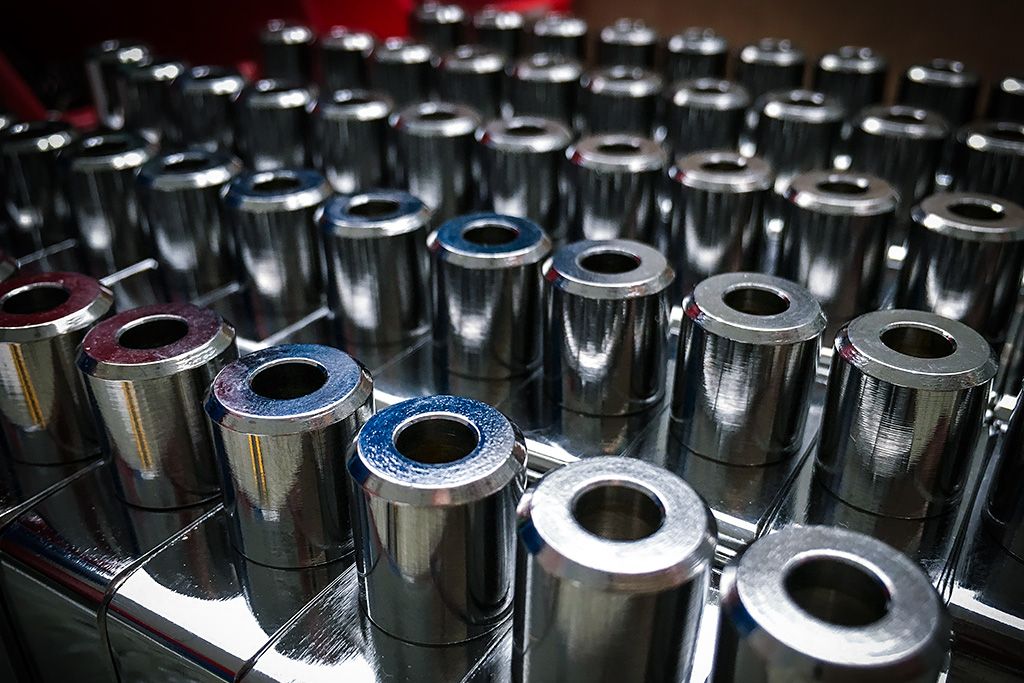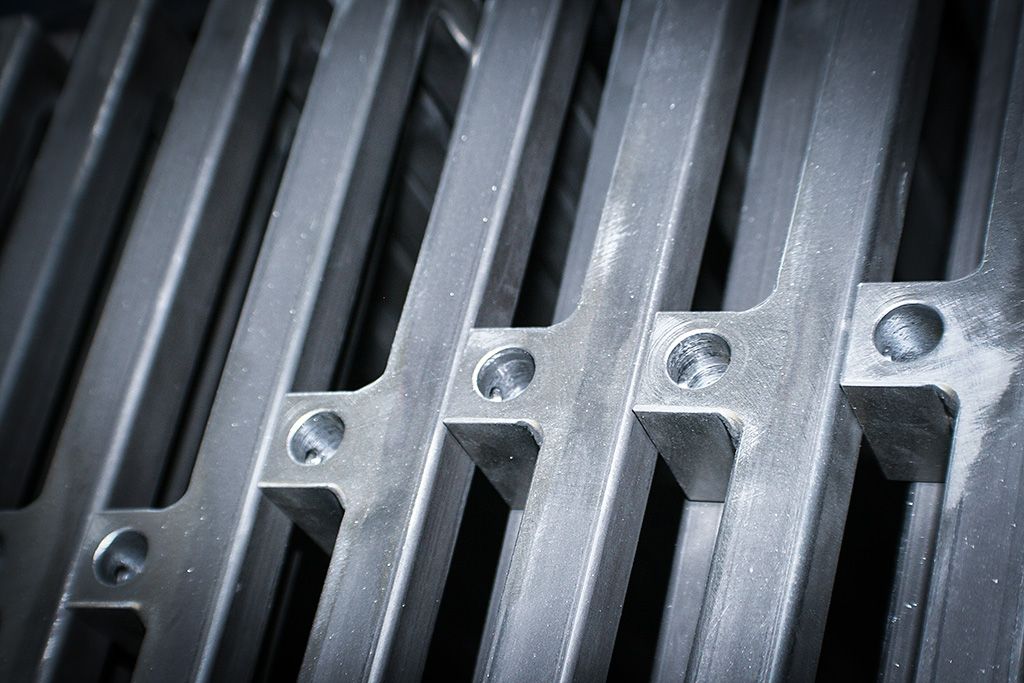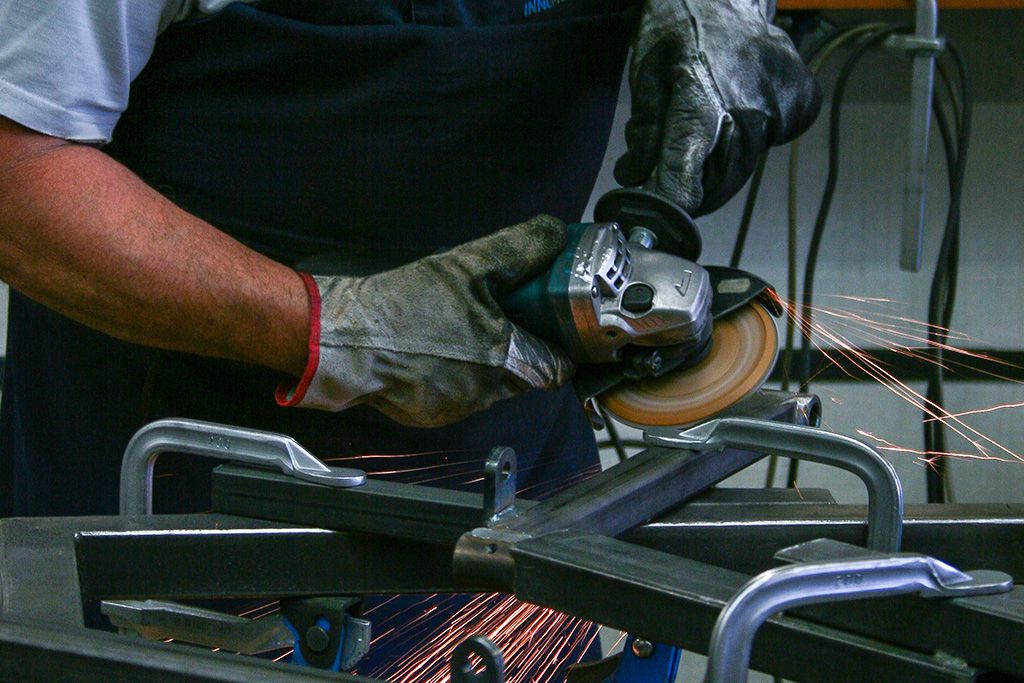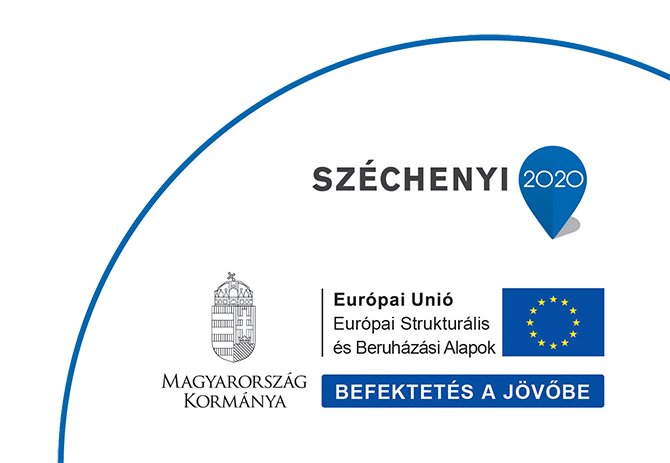In the mechanical engineering and metalworking industries, efficient and precise production is based on various machining processes. Below are the most commonly used metalworking techniques, which play a key role from the processing of the raw material to the finished product.

1. Cutting – the first step in precise production
Cutting is the most important part of metalworking processes One of the first and most decisive operations is to cut raw materials – be it sheets, bars, hollow sections or tubes – to lengths, shapes or pieces according to production needs. The goal: precise, fast and efficient preparation for further machining phases.
Main cutting technologies
Mechanical Cutting
- Manual or machine sawing: for small and medium quantities. For example, the use of a band saw or circular saw.
- Eccentric shears / Sheet metal shears: for fast cutting of sheets.
- Punching: large-scale, fast cutting with a prefabricated tool, typically for thinner sheets.
Thermal Cutting
- Plasma cutting: an efficient process for thicker materials, fast and cost-effective, but it can leave a thermal zone.
- Flame cutting (oxyacetylene): ideal for thick steel plates, but its accuracy is lower.
- Laser cutting: Excellent accuracy and minimal thermal distortion. It can be automated, ideal for industrial production – mainly for stainless steel, aluminum, thin sheets.
- Waterjet cutting: Heat-free process for cutting with high precision. It is more expensive, but does not deform the material – so it is advantageous for sensitive or multi-layered materials.
Cutting aspects:
- Accuracy: dimensional accuracy is key, especially with tight tolerances.
- Preservation of material quality: too much heat input or inappropriate tool selection deteriorates the structure of the material.
- Efficiency: automated cutting machines (e.g. CNC laser cutters, automatic sawing machines) significantly reduce scrap and working time.
- Necessity of rework: e.g. deburring may be necessary after heat cutting.
Industrial use examples:
- In mechanical engineering: preparation of frame structures, casings, parts of consoles.
- In sheet metal processing: cutting of cladding plates and boiler rooms with CNC laser cutting.
- In the construction industry: precise tailoring of hollow sections and profiles for steel structures.
- In the automotive industry: pre-pressing sheet metal cutting, from which the body parts are made.
2. Machining – forming by chip removal
Machining is one of the most important forming processes in metalworking, during which small parts, so-called chips, are separated from the material of the workpiece with the help of a tool. This process allows the parts to be machined to the exact size and achieve the desired surface finish. Machining is typically used when high demands are placed on the dimensional accuracy, shapeliness and surface quality of the product – for example, for jointed, moving or sealing parts.
Types of cutting methods
- Turning: The workpiece rotates while the tool performs the feed movement. It is mainly used to form cylindrical or conical shapes. They are used for machining shafts, bushings, pins.
- Milling: The tool rotates, the workpiece or the tool itself moves along the prescribed path. It is ideal for creating more complex plane, profile and spatial shapes. It is suitable for the formation of ribs, holes, pockets, gears, for example.
- Drilling: Making holes with a round cross-section with a rotary tool. It can be manual or CNC machined. It is often combined with countersinking, reaming for accurate hole quality.
- Planing and chiselling: It is less common today, but it is still used, for example, to create unique, flat or grooved surfaces.
Machine types
- Traditional machines: manual lathe, milling machine – for smaller series, custom production.
- CNC machining machines: high-precision, automated equipment with programmable production cycles – ideal for series production.
- Machining centers (CNC multitasking): milling, drilling, threading and other operations within one machine, even with an automatic tool changer.
Industrial use examples:
- Automotive industry: precise machining of engine parts (e.g. crankshaft, cylinder head).
- Mechanical engineering: design of shafts, bearing housings, drive elements.
- Medical technology: precision milling of titanium implants.
- Aerospace: high-precision machining of aluminum and titanium parts.
3. Drilling and tapping – hole making and preparing screw connections H2
Drilling and tapping are two basic cutting processes that occur in almost any mechanical or metalworking process. The goal: to create holes and screw threads for the assembly of various components, primarily through bolted connections.
Drilling – making the foundation hole
During drilling, a cylindrical hole is formed in the workpiece with the help of a rotating tool (drill). The process seems simple, but there are many factors that affect accuracy and quality:
Types of drilling
- Ordinary drilling – creating basic holes for e.g. screw locations, bearing housings.
- Countersinking – conical or cylindrical expansion of the hole inlet, e.g. for countersunk screw heads.
- Reaming – bringing an existing hole to the exact size with a mirror-smooth surface and tight tolerances.
Threading – Screw Thread Design
During the threading, a screw thread is made inside/outside the hole or cylindrical surface. The thread can be internal (nut) or external (screw).
Marching modes
- Manual thread cutting / tapping: in smaller quantities, common in repair shops.
- Machine tapping: It is done on a CNC or column drilling machine, suitable for serial production.
- Thread rolling (training): forms the thread without chip separation – faster, more durable, but only applicable to ductile materials.
- Thread milling: CNC-controlled threads, especially good for thin-walled or difficult-to-machine materials.
Important parameters
- Driving profile (e.g. metric, Whitworth, trapezoidal)
- Diameter and division (e.g. M6x1, M8x1.25)
- Thread length and direction (right or left)
Industrial significance and areas of application
Drilling and marching are essential in almost every industry:
- Mechanical engineering: shafts, covers, bolted joints of housings.
- Automotive industry: bores and threads of engine blocks, chassis elements.
- Electronic enclosures: fasteners that can be pressed into thin-walled sheets or threaded.
- Construction metalwork: preparation of steel structures, brackets, fasteners.

4. Rolling – plastic forming on an industrial scale
Rolling is one of the most common forms of plastic forming processes, in which the shape of a material (typically metal) is changed by passing between rollers. The essence of the operation is that a compressive force is applied to the workpiece, so that the material flows (becomes malleable) and takes on a new geometric shape – without material separation.
Purpose and benefits of rolling
- Material thickness reduction (sheet metal rolling)
- Increase length or surface area
- Profile design (e.g. ribbed plate, hollow section, rail rolling)
- Creating an arched or cylindrical shape (e.g. pipe shells, tank bodies)
The main types of rolling
Hot rolling
- Occurs at a temperature of 1000-1300 °C (for steel)
- Metal is easy to shape, but the dimensional accuracy is less
- Used in the production of raw material plates, beams, rails
Cold Rolling
- It is done at room temperature
- Less deformation, but higher precision, better surface
- Improves the mechanical properties of the final product (hardness, elasticity)
Application: Thin Steel Sheets, Home Appliances, Automotive Parts
Sheet metal rolling (curved rolling)
- Used for the production of curved, cylindrical shapes (e.g. pipe shells, tank jackets)
- Most often it is done on three- or four-cylinder sheet metal rolling machines
- Both manual and CNC-controlled machines are used
Die Rolling
- For the production of I-profiles, L-sections, U-steels, hollow sections
- The material is formed with pre-formed profile rollers
Industrial applications examples:
- Steel industry: coil plate, rail rolling, hollow sections
- Tank production: rolling of casings for water tanks, pressure vessels
- Sheet metal processing: bending coverings, cladding elements
- Construction: curved cladding elements, trapezoidal sheets, profiled sheets
- Automotive industry: cold rolling of body parts, floor plates
5. Levelling – the key to geometric precision
Straightening is one of the basic, often underestimated, but technologically critical operations of metalworking processes. Its purpose is to restore the straightness, flat surface and dimensional stability of various raw or partially machined metal raw materials, such as sheets, rods, hollow sections or profiles. Deformations – whether bending, twisting or waviness – can occur during various prefabrication processes (e.g. cutting, rolling, welding, storage) and significantly impair fitting, the accuracy of automated machining or even the assembly of the final product.
Why is levelling key?
- Accuracy: A flat surface is essential for machining precision parts (e.g. CNC milling, laser cutting).
- Mountability: Screw or welded joints will only work without problems if the surfaces are aligned.
- Stress relief: In the case of stress-loaded sheets (e.g. rolled or cut), straightening reduces internal distortions of the material.
Types of straightening processes
Mechanical straightening (cylindrical straightening machines)
- The material passes between several rollers (usually 5–15) placed in a row.
- The rollers alternately stretch and bend the fabric until it straightens.
- It is mainly used for thin and medium thickness sheet metal.
- There are manual feeding and automated (CNC) versions.
Pressing or hammering straightening
- It is mainly used for individual or small series pieces and rod materials.
- The workpiece is brought closer to the straight state by means of a local compressive force (e.g. in a vise, with a machine press or hammer).
Heat Straightening
- It is used for larger workpieces or thicker materials.
- With the help of local heat input (e.g. flame or induction heating), they relieve tension, so that the shape of the material can be corrected.
Vibration or ultrasonic straightening
- It is less common, but it can be beneficial for sensitive, thin materials.
- Vibration helps to relieve tension and reduce geometric distortions.
Typical applications in industrial environments
- Sheet metal processing: Before CNC laser cutting, it must be straightened so that the sheet metal does not twist during cutting.
- Hollow sections and bars: for a precise fit of frame structures, machine frames.
- Welded structures: distortions due to heat are corrected after welding.
- Component manufacturing: e.g. straightening of flat coverings, machine base plates, table tops.
6. Deburring and grinding – the basics of precise surface finishing
Deburring and grinding are surface finishing procedures and are designed to improve the usability, safety and aesthetics of the workpiece. While deburring is used to remove unnecessary, sharp, protruding parts (burrs), grinding is used to smooth the surface of parts, reduce roughness or even increase them in a targeted manner. These processes are often the final machining phase, especially in cases where manual installation, touch safety or appearance are important considerations.
Deburring – eliminating hidden hazards
A burr is a small, sharp, broken or thinned piece of material that remains after cutting, cutting, cutting, drilling, milling, or other processes. These are not only dangerous for accidents, but:
- They may interfere with the installation (e.g. screw or connector does not fit snugly)
- They may cause surface treatment defects (e.g. electroplating or does not adhere properly during painting)
- They can lead to measurement inaccuracies
- They can also interfere with the operation of machines and sensors (e.g. CNC collision or sensor misevaluation)
Deburring procedures
- Manual deburring: use of a file, hand scraper, hand sander or countersink – typical for small series.
- Mechanical deburring: brush machines, vibrating or drumming machines – for medium/large series.
- CNC-controlled deburring: performed by automated robot arms or multi-axis machining centers – for precision parts.
- Thermal deburring: burrs are removed by igniting a dried gas mixture – especially in the case of internal channels.
- Ultrasonic or electrochemical deburring: for sensitive components that require high precision.
Sanding – finishing and shaping the surface
During grinding, material is removed from the surface of the workpiece with the help of an abrasive effect. It can be:
- Surface Repair
- Dimensional Accuracy
- Polishing or polishing
- Roughness increase (e.g. for gluing or painting preparation)
Main grinding shapes
- Manual sanding: with sandpaper, hand machines (e.g. angle grinder)
- Belt sanding: with long, continuous sanding belt, for flat or curved surfaces
- Circular grinding: for dimensionally accurate, smooth design of cylindrical surfaces
- Face and profile grinding: for high-precision flat or individual surfaces (e.g. in tool manufacturing)
- Polishing: to achieve an extremely smooth, even mirror-like surface, often with a paste or fine-grained sponge
- Fine grinding: for extremely low roughness – for precision machine components and bearings
Industrial applications examples:
- Sheet metal parts: deburring after laser cutting or punching + grinding for safe handling
- Screw threads: countersinking after the hole, deburring for easy entry
- Mechanical engineering: polishing of shafts, sleeves, bearing surfaces
- Medical technology: mirror polishing of stainless steel implants
- Decorative metal surfaces: e.g. polishing stainless steel covers for the final look

7. PEM extrusion – durable and precise fastening of fasteners in sheet metal parts
PEM (Pressed-in Engineering Mounting, or more commonly: self-clinching fasteners) is a mechanical fastening technology that allows fasteners to be installed in thin metal sheets in a durable and deformation-free manner. During the process, specially designed fasteners (nut, screw, spacer, pin, pin, etc.) are pressed into the base material by pressing, where they are permanently fixed by mechanical closure – without soldering, gluing or welding.
Advantages over other recording methods
- Durable and stable fastening even in thin metal sheets (e.g. less than 1 mm)
- In-line, automatable assembly – fast and accurate installation
- Excellent load capacity – resistant to both pulling and twisting
- Corrosion-resistant design – stainless steel or nickel-plated versions
- Clean, flat surface design – aesthetically pleasing and installation-friendly
- It does not deform the workpiece if it is properly prepared and pressed
What machines are used for injection molding?
- Manual hydraulic or pneumatic presses – for smaller quantities
- Semi-automatic machines – in series production with changeover tools
- CNC controlled pressing stations – for automated production lines
- In many cases, PEM machines detect insertion, pressure force, and give an error signal if a perfect fit has not been made.
Industrial applications – where is it used?
- Electronics enclosures – such as control cabinets, monitor housings, dashboards
- Computer components – power supplies, hard drive slots, fan covers
- Automotive – fuse boxes, cover mounts, cable connectors
- Refrigeration – cladding elements, mounting panel connections
- Sheet metal processing – for any modular or screw-on assembly
Professional concluding remarks
Each of the listed machining processes plays a key role in modern manufacturing. The selection of the right technology determines not only the quality of the product, but also its economy and manufacturability. Metalworking is therefore not only a technical issue, but also a strategic decision – especially in the case of metalworking. Industry 4.0, where automation and precision are becoming more and more important.



